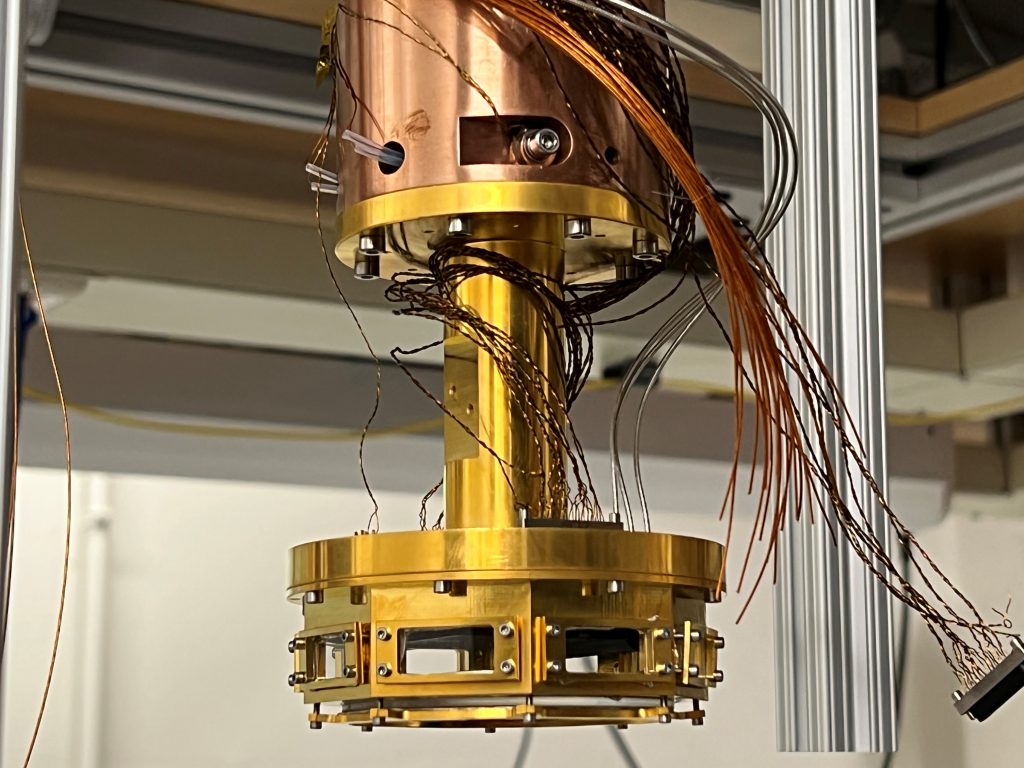Research Program
The DeMarco group works at the frontier of 21st-century quantum science. We explore quantum many-particle physics at the intersection of atomic and condensed matter physics. We also advance distributed quantum computing and quantum networking through a mix of fundamental and applied science. Our group uses four separate instruments: an 87Rb bosonic optical lattice experiment, a 40K fermionic optical lattice experiment, an ultracold NaRb molecule experiment, and a 88Sr+ ion trap experiment.

Optical Lattices
In these experiments, we cool atoms to temperatures just a billionth of a degree above absolute zero. We trap those ultracold atoms in an optical lattice: a periodic potential formed from interfering laser beams. The combination forms an analog quantum simulator for models important to exotic solids. The atoms play the role of either electrons or Cooper pairs, and the lattice that of the ionically or covalently bonded crystalline matrix. Atoms in the lattice are exactly described by a Hubbard model.
Hubbard models are our simplest paradigms for electronic solids in which interactions between electrons play an important role. In a Hubbard model, the electrons can tunnel between adjacent lattice sites, and two electrons on the same site interact with each other. Despite this apparent simplicity, we do not understand some of the most basic features of Hubbard models. Outstanding questions include whether or not Hubbard models give rise to d-wave superconductivity and the impact of disorder on properties such as conductivity. The difficulty in understanding Hubbard models arises because the particles are strongly correlated: the interaction and kinetic energy scales are similar, and thus no single-particle theory (including mean-field theories) can be applied. Furthermore, we can only exactly simulate tens of particles on our most powerful supercomputers, and advances in computing consistent with Moore’s Law enable us to add just one particle every decade. Optical lattice quantum simulation therefore provides access to physics that is unsolved and not computable.

We have two apparatuses for studying Hubbard models using optical lattices. In one, we trap and cool 87Rb atoms, which are bosons. In the other, we use 40K atoms, which are fermions. Every experimental cycle takes about 90 seconds. In one run of the experiment, we cool atoms starting from a room-temperature vapor, transfer them to a region evacuate to about 10-12 torr, and then trap them in an optical lattice. We manipulate the atoms in some way (e.g., push on them using a magnetic field gradient), release the gas from the lattice, and then image using resonant light and a CCD camera. In contrast with experiments on solids that may involve years of material development, we can change the analogue of the material parameters during every 90-second run by adjusting laser intensities.

Our group has pioneered several directions in optical-lattice quantum simulation. One focus is the how the combination of interactions and disorder give rise to new quantum phases and dynamics in three dimensions. We were the first group to observe the superfluid-to-Bose glass transition in 3D, the first realization of 3D Anderson localization of quantum matter, and the first to obtain evidence for many-body localization in 3D.
We also specialize in investigating out-of-equilibrium dynamics as a key probe of quantum matter. We were the first to observe the quantum analog of the Kibble-Zurek effect for a quench across a quantum phase transition. And, we realized the first quantum quench of disorder.
Now, we are retooling these experiments to investigate the influence of strong interactions and disorder on fully spatially and temporally resolved diffusion dynamics.

Ultracold Molecules
This effort is a collaboration with Prof. Bryce Gadway to trap and cool NaRb molecules to ultracold temperatures. Our goal is to use this platform to simulate models of magnetism and quantum chromo-dynamics and to perform measurement-based quantum computing. We are currently building up the capabilities to cool Na and Rb atoms, join them into ground-state molecules, and then completely control and detect their quantum states.

Trapped Ion Quantum Computing
Trapped atomic ions are on one of the leading platforms for quantum computing. In these experiments, we are creating distributed quantum computing and quantum repeater architectures, which are key elements needed to advance quantum computing. In collaboration with MIT Lincoln Lab, we are building up a new trapped ion quantum computer in the IQUIST testbed. We will trap quantum registers composed of 88Sr+ ions confined to a cryogenic chip trap. Remote entanglement generation will be used to distribute quantum circuits across these registers.
These experiments are a collaboration with Prof. Jacob Covey and Prof. Elizabeth Goldschmidt. With Prof. Goldschmidt, we are developing an approach to covert light emitted by the ions to telecommunication wavelengths, which can be launched onto a quantum network.